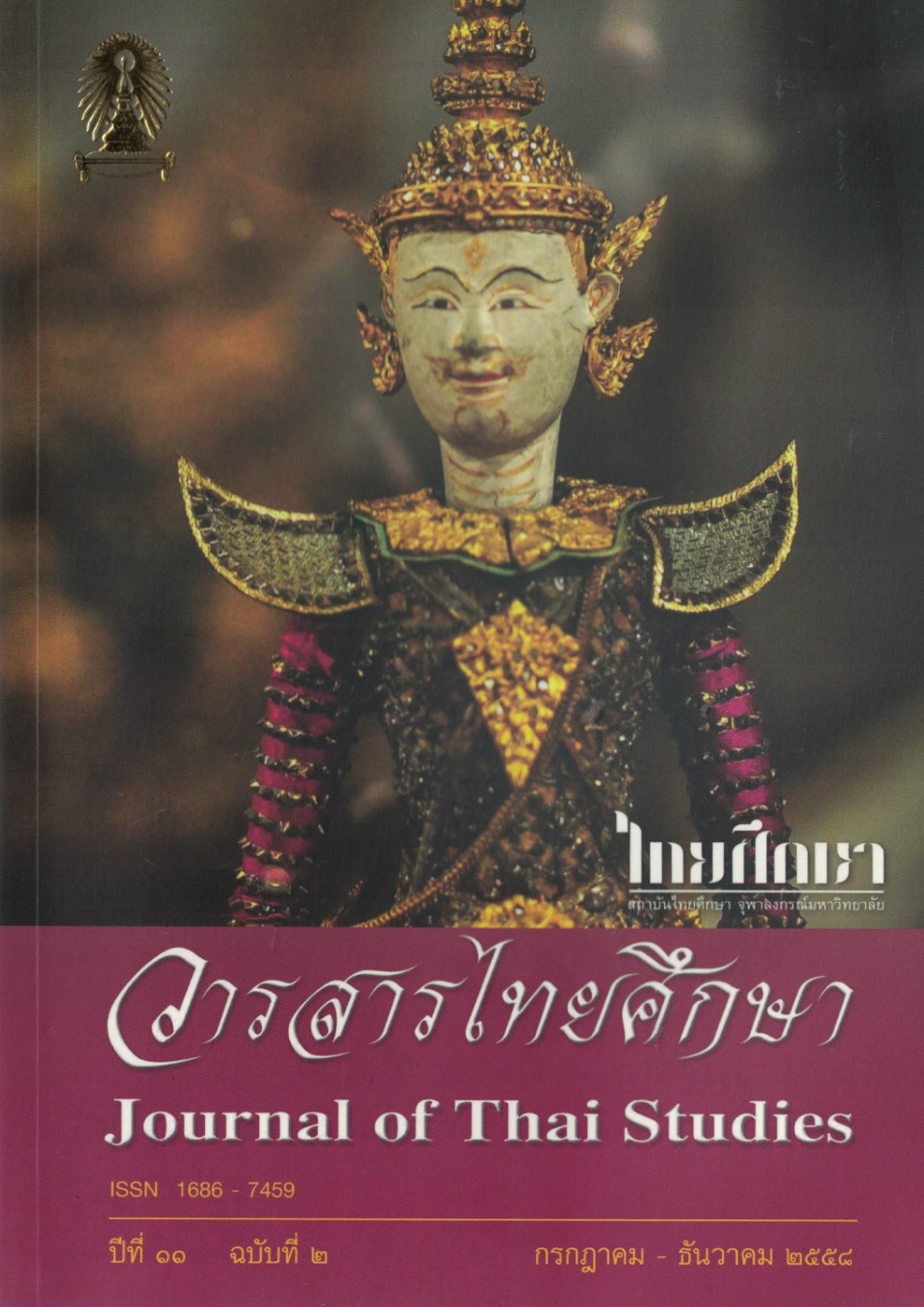The Concept of “Civilization” in the Early Bangkok Tourist Guide of Thailand
Main Article Content
Abstract
This article aims to analyze the concept of “civilization as” reflected by the representation of the identities of “State Temples and Palaces” on Rattanakosin Island from a documentary work entitled “Exploring Bangkok through archaeological tour” of M.C. Phunphitsamai Ditsakun. This book is the first Bangkok tourist guide influenced by conventional concept of civilization produced by the Siamese court that aimed to change Thais’ viewpoint “State about Temples and Palaces”, from being sacred spaces to being the center of Buddhist civilization. It is clear that this book is the exemplar of how civilization knowledge was constructed through the lens of an elite scholar in the early Bangkok tourism period, as well as the beginning of Bangkok tourism based on academic knowledge.
The study reveals that the concept of civilization is a conventional concept appearing in Thai elites’ works which has been used through times. In such a context, Buddhist Civilization is a prominent aspect of Thai civilization appearing in this sort of work. The image of Bangkok as a “Buddhist City” is the outstanding image in this book. The significance of Thai Buddhism in this term is portrayed as a tool for creation of Buddhist city and the establishment of state temples for learning by Thais. The identities of Buddhist culture are represented by the narration of the historical backgrounds. of state temples, palaces, and Buddhist architecture. The characteristics of Buddhist arts also portrays the continuous Buddhist civilization of Thai kingdoms from Sukhothai, Ayutthaya to the Rattanakosin period.
Downloads
Article Details

This work is licensed under a Creative Commons Attribution-NonCommercial-NoDerivatives 4.0 International License.
Journal of Thai studies is licensed under a Creative Commons Attribution-Noncommercial-NoDerivatives4.0 Intenational (CC BY-NC-ND 4.0) licence, unless otherwise stated. Plese read our Policies page for more information on Open Access, copyright and permissions.
References
กรมศิลปากร, หอพระสมุดวชิรญาณสำหรับพระนคร. กรุงเทพฯ: กรมศิลปากร, ๒๕๔๑.
กรมหมื่นพิทยาลาภพฤฒิยากร, พระวรวงศ์เธอ, พระนิพนธ์บางเรื่อง พระวรวงศ์เธอ กรมหมื่นพิทยลาภพฤฒิยากร พิมพ์ในงานฉลองพระชันษาครบ ๘๔ พ.ศ. ๒๕๑๒.
คริส เบเคอร์ และผาสุก พงษ์ไพจิตร, ประวัติศาสตร์ไทยร่วมสมัย (กรุงเทพฯ: มติชน, ๒๕๕๗).
จุลจอมเกล้าเจ้าอยู่หัว, พระบาทสมเด็จพระ. ตำนานพระแก้วมรกต. พระนคร : โรงพิมพ์ศาสนศึกษา, ๒๔๙๔.
จอมเกล้าเจ้าอยู่หัว, พระบาทสมเด็จพระ. ตำนานพระแก้วมรกต. พระนคร: บรรณาคาร, ๒๕๐๔.
ธงชัย วินิจจะกูล.“ภาวะอย่างไรหนอที่เรียกว่าศิวิไลซ์: เมื่อชนชั้นนาสยามสมัยรัชกาลที่ ๕ แสวงหาสถานะของตนเอง ผ่านการเดินทางและพิพิธภัณฑ์ทั้งในและนอกประเทศ” รัฐศาสตร์สาร, ปีที่ ๒๔, ฉบับที่ ๒ (๒๕๔๖):๑-๖๖.
ธรรมทาส พานิช, วัฒนธรรมพุทธศาสนาของชาวไทยในตำนานพระแก้วมรกต. กรุงเทพฯ: อรุณวิทยา : ธรรมทานมูลนิธิ, ๒๕๔๒.
ดำรงราชานุภาพ, สมเด็จกรมพระยา. ตำนานพระพุทธรูปสำคัญ. พระนคร : โรงพิมพ์โสภณพิพรรฒธนากร, ๒๔๖๘.
______. พระราชพงศาวดารกรุงรัตนโกสินทร์รัชกาลที่ ๒ : พระนิพนธ์สมเด็จพระเจ้าบรมวงศ์เธอ กรมพระยาดำรงราชานุภาพ, พิมพ์ครั้งที่ ๖ กรุงเทพฯ: กรมศิลปากร, ๒๕๑๑.
บุนนาค พยัคฆเดช, พระบรมราชาธิบายของรัชกาลที่ ๕. พระนคร: คลังวิทยา, ๒๕๐๕.
พูนพิศมัย ดิศกุล, หม่อมเจ้าหญิง. นำเที่ยวกรุงเทพฯทางโบราณคดี. พระนคร: โรงพิมพ์พระจันทร์, ๒๔๙๑.
______. สารคดีน่ารู้. ธนบุรี: นครหลวง, ๒๕๑๖.
วสุรัตน์ ว่องไวกลยุทธ, การเกิดวาทกรรมแรกเริ่มว่าด้วยพุทธศาสนาเป็นวิทยาศาสตร์ในไทย วารสารชุมนุมประวัติศาสตร์, ฉบับที่ ๔, (๒๕๕๕) หน้า ๘๑-๘๒.
สายชล สัตยานุรักษ์. ๑๐ ปัญญาชนสยาม. กรุงเทพฯ: Openbooks, ๒๕๕๗.
______. การสร้าง “ความเป็นไทย” กระแสหลักและ“ความจริง” ที่ “ความเป็นไทย” สร้าง, (เอกสารอัดสำเนา).
สรตี ใจสะอาด, จดหมายเหตุรายวัน พระราชนิพนธ์ในพระบาทสมเด็จพระจุลจอมเกล้าเจ้าอยู่หัว: ต้นเค้าการเขียนสารคดีท่องเที่ยวยุคแรกของไทย วิทยานิพนธ์อักษรศาสตรมหาบัณฑิต ภาควิชาภาษาไทย คณะอักษรศาสตร์ จุฬาลงกรณ์มหาวิทยาลัย, ๒๕๔๔.
อรรถจักร สัตยานุรักษ์. การเปลี่ยนแปลงโลกทัศน์ของชนชั้นผู้นำไทยตั้งแต่รัชกาลที่ ๔ ถึงพุทธศักราช ๒๔๗๕. พิมพ์ครั้งที่ ๓. กรุงเทพฯ: สำนักพิมพ์แห่งจุฬาลงกรณ์มหาวิทยาลัย, ๒๕๕๕.
ออนไลน์
นวพรรณ ภัทรมูล , “เล่าเรื่อง: นายเรืองและนายนกผู้เผาตัว”, สืบค้นจาก http://www.sac.or.th/main/article_detail.php?article_id=96&category_id=19, ๒๓ กรกฎาคม ๒๕๕๘
ภาษาอังกฤษ
Panu Wongcha-um. What’s Thai cuisines Thai Culinary Identity Constructing from The Rise of Tha Bangkok Dynasty to Its Revival, Master of Arts, Department of History, National University of Singapore, 2009.


